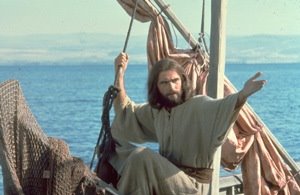Non-Lucan Dialogue in Jesus
 It's often thought that Jesus (1979, aka The Jesus Film) is taken word for word from Luke's gospel. In fact this is patently not the case. There are all kinds of places where words are spoken / dubbed over that do not originate in Luke gospel. As I recently re-watched the film as part of my prep for my podcast about it, I thought I'd give a quick run-down on the five different types of non-Lucan dialogue that are found in the film. As there are various different versions of this film around now I should clarify that the following in based on the 2 hour version of the film that I believe was the original cut.
It's often thought that Jesus (1979, aka The Jesus Film) is taken word for word from Luke's gospel. In fact this is patently not the case. There are all kinds of places where words are spoken / dubbed over that do not originate in Luke gospel. As I recently re-watched the film as part of my prep for my podcast about it, I thought I'd give a quick run-down on the five different types of non-Lucan dialogue that are found in the film. As there are various different versions of this film around now I should clarify that the following in based on the 2 hour version of the film that I believe was the original cut.1 - Prologue / Epilogue
This I suppose is a little obvious, and some would not classify the opening and closing narrated sections as part of the film at all. But, to me, they are part of the film. Both sections are narrated and feature text from John even as the opening section notes how the film is based on Luke. The ending is longer, and whilst it starts off quoting John 3:16, it's the beginning of a mini-sermon and altar call.
2 - Narration
Whilst much of the film's narration is lifted straight from Luke, there are exceptions in addition to those already noted. For example, towards the end of the film the narrator tells us that Pilate was responsible for the "crucifixion of thousands".
3 - Background Comments
Perhaps the most frequent type of insertion is in the form of exclamations from the crowd. These occur in virtually every scene, and whilst they may be seen as background they are often clear enough to be distinct, and some are included in the subtitles. For example when the widow puts her mites in the offering we hear someone say "it's very little" or when Jesus is mocked the guards say "how does it feel to look up to somebody?". Given how this film is re-dubbed depending on the language of the audience watching it, I wonder how many of these comments are translated as well. I imagine, given their clarity, that many of them would also be included in the soundtracks for other languages.
4 - Dialogue from Major Characters
There are a few occasions when one of the principals says something that is not from Luke. For example, in the resurrection scene the women find the empty tomb and see the angels appear and then rush back to the disciples and recount what has happened, whereas as Luke only tells us that they recounted it. And as Peter rushes off to go verify their story Mary says "Peter, you must believe us". Perhaps the largest such insertion comes from Peter himself. When Peter hears the cock crow he prays the following prayer which is taken from one of the Dead Sea Scrolls of all places (see here):
Lord we beseech thee do as thou ought in accordance with the greatness of thy power. Thou who did forgive our fathers when they rebelled against thy word. Thou who was angry with them. Thou who did not destroy them because of thy love for them and for thy covenant's sake. Thou did spare them.5 - Jesus's Dialogue
The most unexpected source of dialogue not from Luke is that spoken by Jesus himself. Examples of this are relatively few, but two notable examples are when Luke simply tells us that he prayed, without telling us what he prayed. The film makes its own suggestions. For example, both before the feeding of the five thousand and as he blesses the bread at the Last Supper, Jesus prays the prayer from the Passover Shema "Blessed art thou oh God who brings forth fruit from the earth".
I've been trying to estimate how much of the film's dialogue is imported, but without recording every word it would prove tricky. I would perhaps estimate somewhere in the region of 10%, but to be honest that's pure guess work. I should point out as well, that most of the footage used in Jesus is taken from a longer 4 hour word for word version of Luke's gospel.
Labels: Jesus (1979)














2 Comments:
At 1:26 pm, August 24, 2008, Patrick said…
Patrick said…
Wasn't there also a scene showing Pilate talking with the priests (I'm working with memory here, however)?
Also, I'd like to note the fact that the Japanese version of the Jesus film had an added dialogue during the crucifixion. One of these is someone (perhaps the centurion) barking at one of the criminals moaning in pain as he is being nailed to the cross to be quiet.
At 7:40 am, August 25, 2008, Matt Page said…
Matt Page said…
Hi Patrick,
Thanks for those. You could well be right on Pilate. My aim was to categorise the types of addition, rather than provide an exhaustive list so I guess that would fall into category "4", although perhaps it's another whole category.
I think the Japanese example may be there in the English as well. I guess that would be a "3".
Matt
Post a Comment
<< Home